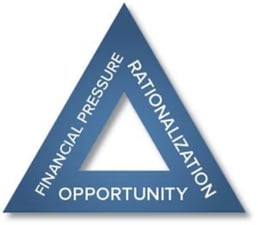R&D stakeholders trust procurement professionals to operate with their best interests at heart. But unfortunately, procurement is sometimes the unexpected culprit of bribery, corruption, and collusion — hiding in plain sight. Research shows that businesses lose around 5% of spend per year to procurement fraud, with annual losses ranging from $10,000 to $150,000. Worse, 33% of leaders are unaware of the danger and unable to say how much they lose from it. Continuous monitoring and effective controls are the best weapons to prevent procurement fraud, but are time-intensive and failure-prone due to human bias and error. Luckily, life sciences has powerful allies in the fight against procurement fraud through the use of artificial intelligence (AI) and lab supply marketplaces.
What is procurement fraud?
Procurement fraud occurs when an employee, partner, or supplier behaves unethically or deceptively for financial gain or advantage.
What are the types of procurement fraud?
Procurement fraud is one of the most commonly reported types of organizational fraud. Since there are many steps in the procurement process that are vulnerable to bad actors, it is critical to become familiar with the main categories of procurement fraud, including:
- Financial deception. Includes invoice fraud, creation of ghost employees or companies with the intent of fund misappropriation, and approval of inflated bills or accepting underdelivery.
- Quality and specification breaches. Includes unapproved product substitutions, false claims about goods or services, and making of or accepting false statements when obtaining contracts.
- Ethical violations. Includes undisclosed conflicts of interest that affect fair decision-making, employee/supplier collusion for personal gain, kickbacks, and manipulating data with the intent to deceive stakeholders.
- Unjustified practices. Includes bypassing the competitive bidding process to select a single supplier without proper justification.
- Collusive practices. Includes bid rigging and price fixing in which competing suppliers collude to ensure a specific supplier wins the contract. This practice is more common in categories with high startup and entry costs and fewer bidders.
What is the fraud triangle?
The Association of Certified Fraud Examiners (ACFE) uses the concept of the fraud triangle to explore the contributing factors to employee fraud.

Fraud Triangle, courtesy of ACFE
- Financial pressure. Financial strain arising from factors such as addiction, unexpected medical bills, personal debt, or a desire for a lifestyle beyond their means can drive fraud. Work-related dissatisfaction may also drive fraud as a retaliation vehicle for employees who feel underpaid or overlooked.
- Opportunity. The opportunity to commit fraud in an undetectable way must be present. This occurs when assets are easily accessible or inadequately monitored, and when the organization lacks effective internal fraud-prevention controls.
- Rationalization. “The company owes me” or “It’s for the greater good” are examples of thoughts employees may have to rationalize fraudulent actions.
By understanding the motivations and rationale behind procurement fraud, organizations can improve their fraud detection, monitoring, and mitigation exercises.
When should labs begin to monitor for procurement fraud?
Of course, companies should watch for fraud regardless of their stage, but fraud prevention should be prioritized as labs scale. A startup’s procurement process is usually more transparent and limited to a small number of touchpoints. As companies scale, the process becomes more cumbersome and data more siloed. With the addition of employees, locations, budget, and steps in the supplier approval chain, visibility into employees’ daily activities becomes more obscured and fraud gets easier to conceal.
The level of procurement process automation can also impact the potential for fraud; the more automated the process, the less opportunity for fraud.
What are the warning signs of procurement fraud?
The best offense is a good defense. The key warning signs of procurement fraud are:
- Split purchase orders
- Invoice mismatches
- Bids that are unusually high or low, as well as last-minute contract-winning bids
- A sudden, unexplainable rise in customer complaints
- Excessive inventory shrinkage
- Unexpected procurement/supplier relationship, in the form of unexpected gifts or a connection outside of work, possibly as seen on social media
What are ways organizations can use AI to prevent procurement fraud?
Manual fraud detection using dashboards and reports is not only time-consuming, prone to error, and insufficient, it can in fact, serve to worsen the risk of fraud. AI-driven data analytics can identify complex patterns and anomalies in procurement data not visible to humans, using machine learning (ML) to analyze historical transactional data and detect inconsistencies, raising red flags for further investigation. AI can be used in multiple ways, such as:
- Risk assessment through analyzing variables like supplier history, industry benchmarks, and compliance regulations, calculating risk scores for transactions, and employing predictive models to identify high-risk situations in real-time.
- Use of Natural Language Processing (NLP) to analyze unstructured data sources, such as emails and contracts, identifying suspicious content, relationships, conflicts of interest, or abnormal communication patterns.
- Real-time monitoring and anomaly detection to flag irregularities like sudden price spikes or unauthorized vendor changes for immediate action.
- Use of network analysis and social graphs to identify hidden connections, collusive bidding, or kickback schemes through the analysis of relationships between suppliers, employees, and stakeholders.
What are the benefits and limitations of using AI for procurement fraud prevention?
Benefits: AI-powered tools enhance fraud detection by analyzing large datasets in real-time, quickly identifying fraud risks and patterns that may elude human detection. This not only increases accuracy but acts as a deterrent to potential bad actors. AI’s continuous learning capabilities adapt to evolving fraud patterns, minimizing false positives and negatives.
Limitations: No one AI solution currently addresses all complexities of the procurement lifecycle, and undocumented, subjective aspects like business case justification pose challenges for electronic detection. AI can combine and monitor data from across the business, including supplier onboarding, bidding, contract management, and invoicing, to identify procurement fraud risks; however, developing effective machine learning for detection requires a substantial quantity of well-trained historical procurement data. While AI augments procurement processes, ethical use with human oversight is crucial for transparency, fairness, and efficiency in preventing fraudulent activities and financial losses for organizations.
How can use of a lab supply marketplace help prevent procurement fraud?
Only 17% of organizations are using AI to detect procurement fraud, citing expense, training, lack of internal ownership, and preference for manual monitoring as barriers to usage. Making procurement processes as automated, transparent, and objective as possible can help labs prevent a level of fraud.
With a lab supply marketplace, such as ZAGENO, users can experience a fully automated, transparent lab supply purchasing process, removing the blind spots and loopholes in which procurement fraud can lurk. End users can build a cart from millions of products across thousands of pre-vetted suppliers with one sole vendor of record and one consolidated invoice each month. Features include three-way matching, streamlined approval flows, risk-vetted suppliers, automated vendor set-up and management, order placement automation, consolidated product liability terms and vendor due diligence, and a clear, real-time audit trail.
With ZAGENO's lab supply marketplace, you can experience a transparent, automated procurement process, eliminating blind spots and loopholes where fraud may occur. Don't let fraud jeopardize your precious resources—contact ZAGENO today for a secure and efficient lab supply procurement process.




